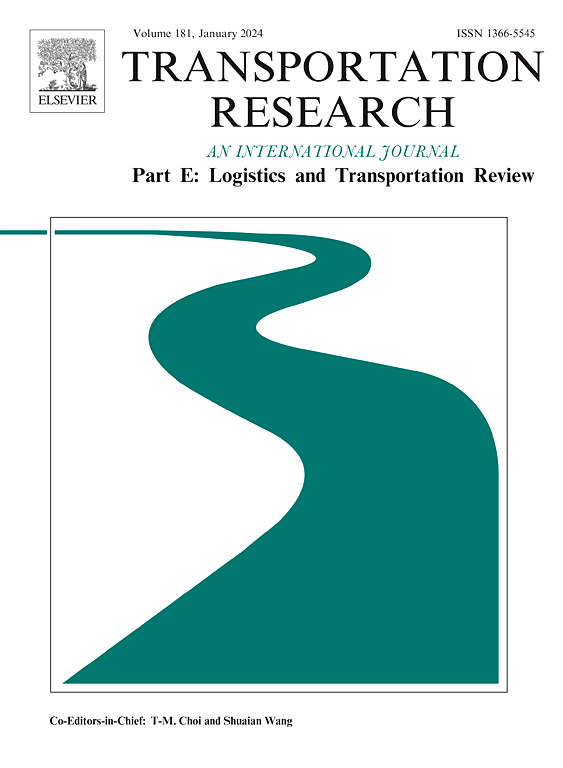Stockyard allocation in dry bulk ports considering resource consumption reduction of spraying operations
IF 8.3
1区 工程技术
Q1 ECONOMICS
Transportation Research Part E-Logistics and Transportation Review
Pub Date : 2024-10-30
DOI:10.1016/j.tre.2024.103816
引用次数: 0
Abstract
Stockyard allocation is a crucial segment of operational decision-making in dry bulk ports (DBPs). The stockyard allocation plan determines the storage position and duration of each stockpile to avoid operational delays in stockyards. Spraying operations, a unique operation in DBPs, are significantly influenced by stockyard allocation plans. Port operators regularly conduct spraying operations to prevent dust diffusion during the storage of dry bulk materials in stockyards. The spraying operation system consumes substantial electrical energy to transport the water to the designated material pile and spray large amounts of water onto its surface. Due to the layout constraints of pipelines and spraying nozzles, different stockyard allocation plans lead the varying consumptions of electrical energy and water resources for spraying operations. However, previous studies on the stockyard allocation problem frequently ignore the impacts of the stockyard allocation plan on the resource consumption of spraying operations. To fill this gap, this paper proposes a stockyard allocation model that uniquely considers the resource consumption of spraying operations to balance operation efficiency and resource consumption in stockyards from a global perspective. With the goal of minimizing the total cost, including operation delay penalties in stockyards and the electricity and water costs of spraying operations, a series of comprehensive experiments was conducted based on practical data collected from a major DBP in China under varying stockpile densities and stockyard efficiency properties. The results clearly show significant differences in the stockyard allocation plan and the total cost resulting from considering and disregarding the resource consumption of spraying operations in the stockyard allocation decision-making process. With only a 3.09% increase in average delay time in stockyards, the proposed model can reduce the total cost by 19.26%, the electricity cost by 54.06% and the water cost reduction by 35.09%. Meanwhile, the carbon emissions are reduced 75 tons on average for spraying operations and the Whale Optimization Algorithm (WOA) performs well on large-scale instances. The proposed model can avoid unnecessary resource consumption of spraying operations with acceptable operation delay penalties in stockyards.
考虑到减少喷洒作业的资源消耗,干散货港口的堆场分配
堆场分配是干散货港口(DBPs)运营决策的关键环节。堆场分配计划决定了每个堆场的存储位置和持续时间,以避免堆场作业延误。喷洒作业是干散货港口的一项独特作业,受堆场分配计划的影响很大。港口运营商定期进行喷洒作业,以防止干散装物料在堆场储存期间的粉尘扩散。喷淋作业系统需要消耗大量电能,才能将水输送到指定的物料堆,并将大量的水喷洒到物料堆表面。由于管道和喷嘴布局的限制,不同的堆场分配方案导致喷洒作业的电能和水资源消耗各不相同。然而,以往关于堆场分配问题的研究往往忽略了堆场分配方案对喷洒作业资源消耗的影响。为了填补这一空白,本文提出了一种堆场分配模型,该模型独特地考虑了喷洒作业的资源消耗,从全局角度平衡了堆场的作业效率和资源消耗。以总成本(包括堆场作业延迟惩罚和喷洒作业的电费和水费)最小化为目标,在不同堆存密度和堆场效率属性下,基于从中国某主要 DBP 收集的实际数据进行了一系列综合实验。结果清楚地表明,在堆场分配决策过程中考虑和不考虑喷洒作业的资源消耗,在堆场分配方案和总成本方面会产生显著差异。在堆场平均延迟时间仅增加 3.09% 的情况下,所提出的模型可使总成本降低 19.26%,电费降低 54.06%,水费降低 35.09%。同时,喷洒作业的碳排放量平均减少了 75 吨,鲸鱼优化算法(WOA)在大规模实例中表现良好。所提出的模型可避免不必要的喷洒作业资源消耗,同时可接受堆场中的作业延迟惩罚。
本文章由计算机程序翻译,如有差异,请以英文原文为准。
求助全文
约1分钟内获得全文
求助全文
来源期刊
CiteScore
16.20
自引率
16.00%
发文量
285
审稿时长
62 days
期刊介绍:
Transportation Research Part E: Logistics and Transportation Review is a reputable journal that publishes high-quality articles covering a wide range of topics in the field of logistics and transportation research. The journal welcomes submissions on various subjects, including transport economics, transport infrastructure and investment appraisal, evaluation of public policies related to transportation, empirical and analytical studies of logistics management practices and performance, logistics and operations models, and logistics and supply chain management.
Part E aims to provide informative and well-researched articles that contribute to the understanding and advancement of the field. The content of the journal is complementary to other prestigious journals in transportation research, such as Transportation Research Part A: Policy and Practice, Part B: Methodological, Part C: Emerging Technologies, Part D: Transport and Environment, and Part F: Traffic Psychology and Behaviour. Together, these journals form a comprehensive and cohesive reference for current research in transportation science.

 求助内容:
求助内容: 应助结果提醒方式:
应助结果提醒方式:


